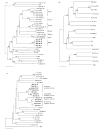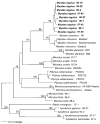Muju virus, a novel hantavirus harboured by the arvicolid rodent Myodes regulus in Korea
- PMID: 17947538
- PMCID: PMC2253664
- DOI: 10.1099/vir.0.83139-0
Muju virus, a novel hantavirus harboured by the arvicolid rodent Myodes regulus in Korea
Abstract
Acute-phase sera from >5 % of cases of haemorrhagic fever with renal syndrome occurring annually in Korea have been found to exhibit a fourfold or higher antibody titre to Puumala virus (PUUV) than to Hantaan virus (HTNV) by double-sandwich IgM ELISA, suggesting the existence of a PUUV-related hantavirus. Based on the phylogenetic relationships among arvicolid rodents, the royal vole (Myodes regulus) was targeted as a likely reservoir host of hantavirus. Using RT-PCR, a genetically distinct hantavirus, designated Muju virus (MUJV), was detected in lung tissue of royal voles, captured in widely separated geographical regions in Korea during 1996-2007. Pairwise analysis of the full-length S (1857 nt) and M (3634 nt) segments of MUJV indicated approximately 77 % sequence similarity with PUUV. At the amino acid level, MUJV differed from PUUV by 5.5-6.9 % (nucleocapsid) and 10.0-11.6 % (Gn and Gc envelope glycoproteins). Interstrain variation of MUJV sequences from royal voles captured in different regions suggested geographic-specific clustering. Neutralizing antibody titres against PUUV were two- to sixfold higher than to HTNV in sera of MUJV-infected Myodes regulus. Although virus isolation attempts were unsuccessful, the collective data indicate that MUJV is a distinct hantavirus species.
Figures



References
-
- Baek LJ, Song JW, Park KS, Kho EY, Ryu SH, Yanagihara R, Song KJ. Seroepizootiology of hantavirus infection in indigenous rodents in Korea, during 1995–2000. J Microbiol Biotechnol. 2002;12:53–58.
-
- Baek LJ, Kariwa H, Lokugamage K, Yoshimatsu K, Arikawa J, Takashima I, Chung SY, Lee EJ, Moon SS, et al. Soochong virus: a genetically distinct hantavirus isolated from Apodemus peninsulae in Korea. J Med Virol. 2006;78:290–297. - PubMed
-
- Brummer-Korvenkontio M, Vaheri A, Hovi T, von Bonsdorff CH, Vuorimies J, Manni T, Penttinen K, Oker-Blom N, Lähdevirta J. Nephropathia epidemica: detection of antigen in bank voles and serologic diagnosis of human infection. J Infect Dis. 1980;141:131–134. - PubMed
-
- Gajdusek DC. Hemorrhagic fevers in Asia: a problem in medical ecology. Geog Rev. 1956;46:20–42.
Publication types
MeSH terms
Substances
Associated data
- Actions
- Actions
- Actions
- Actions
- Actions
- Actions
- Actions
- Actions
- Actions
- Actions
- Actions
- Actions
- Actions
- Actions
- Actions
- Actions
- Actions
- Actions
- Actions
- Actions
Grants and funding
LinkOut - more resources
Full Text Sources
Medical
Molecular Biology Databases
Research Materials
Miscellaneous

